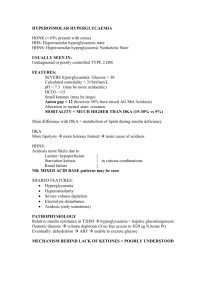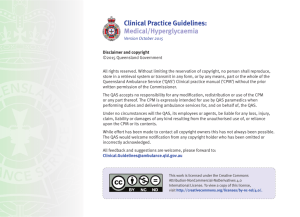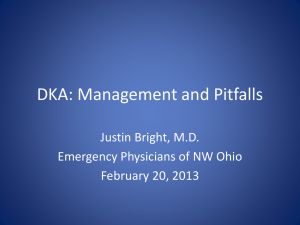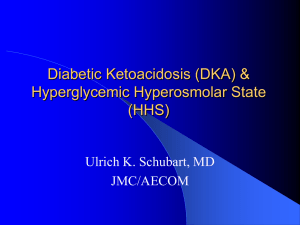Hyperglycaemia
advertisement
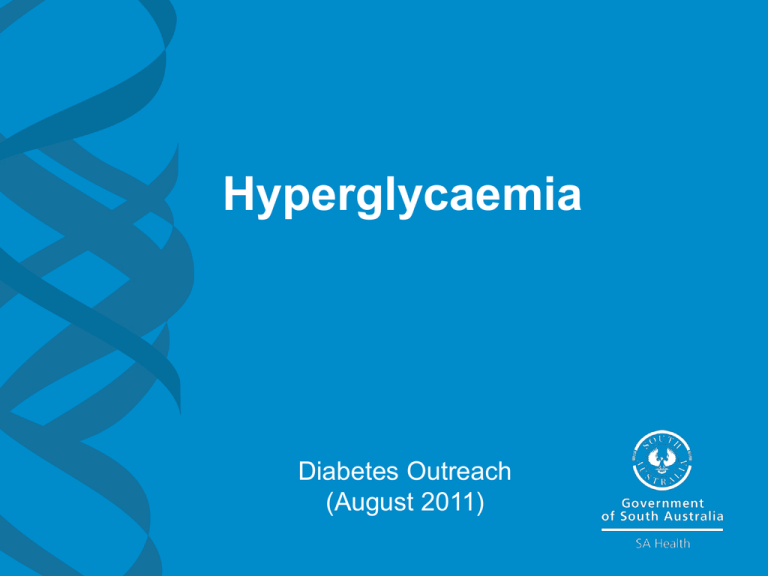
Hyperglycaemia Diabetes Outreach (August 2011) Hyperglycaemia Learning objectives > Can state what hyperglycaemia is > Is aware of the short term and long term complications associated with hyperglycaemia > Can state what causes hyperglycaemia > Is aware of the management and prevention of diabetic ketoacidosis (DKA) and hyperglycaemic hyperosmolar state (HHS). 2 What is hyperglycaemia? > defined as a fasting BGL ≥7mmol/L and post prandial ≥11.1mmol/L > symptoms usually occur when BGL >15mmol/L > if not treated hyperglycaemia can lead to > diabetic ketoacidosis (type 1) > hyperglycaemic hyperosmolar state (type 2). 3 Primary causes of hyperglycaemia > > > > > > > > insufficient insulin or omission insufficient OHAs or omission infection and illness surgery excessive carbohydrate intake stress rebound hyperglycaemia other medications eg steroids. 4 Hyperglycaemic hyperosmolar state (HHS) > significant mortality (15%) > occurs most frequently in elderly people with type 2 > life threatening with severe hyperglycaemia leading to severe dehydration. 5 What happens in HHS can be gradual Very high BGL (body tries to get rid of the glucose via the kidneys - polyuria polydipsia) Electrolyte imbalance and dehydration (every time the body gets rid of excess glucose it sucks out more fluid and this disrupts electrolytes like potassium in the body) Impaired conscious state (The body is unable to replace all the fluids lost and the person is now in danger of severe dehydration) Coma and possible DEATH 6 Signs of HHS Fluid movement from the cell and dehydration lead to: > decreased skin elasticity > low blood pressure > fever > drowsiness > confusion > convulsion and coma. 7 Management of HHS > > > > > > hospitalisation rehydration (because of dehydration) insulin therapy (because of high BGL) monitor glucose and electrolyte balance continue observation of vital signs identify precipitating factors. 8 Prevention of HHS What can health professionals do to prevent HHS? 9 Diabetic ketoacidosis (DKA) > Results from an absence of insulin (type 1 diabetes only). > Low levels of insulin means that glucose cannot nourish cells. > Tissues become starved for glucose. > To prevent cell death from starvation the body breaks down fat and muscle for energy, resulting in a bi-product called ketones. 10 What happens in DKA? Insulin deficiency ↓ glucose lipolysis ketogenesis glycogenolysis gluconeogenesis hyperglycaemia ketosis acidosis uptake into tissue osmotic diuresis vomiting severe dehydration 11 Causes and contributing factors > > > > > illness or infection inadequate insulin dose first presentation of type 1 diabetes myocardial infarction, CVA trauma, surgery. 12 Clinical features of DKA > > > > > > > signs of hyperglycaemia dehydration ketonuria electrolyte imbalance hyperventilation (Kussmaul’s) ketotic breath gastro intestinal (nausea, vomiting, abdominal pain) > disturbed conscious state and shock. 13 DKA treatment Goals: > to correct fluid and electrolyte imbalance > to correct metabolic acidosis > provide insulin to correct acidosis and lower blood glucose > identify precipitating factors to prevent recurrence. 14 DKA Treatment Assessment and history: > laboratory analysis > electrolyte and osmolality > (K+ and Na NCO3) > arterial blood gas (metabolic acidosis) > state of dehydration > cause of ketoacidosis. 15 DKA treatment Management: > start insulin infusion at 5-8 units per hour via an infusion pump > replace fluids with normal saline (eg give 2000ml over 2 hrs) > start potassium replacement from 3rd litre of NS > once BSL ≤ 12mmol/L switch fluid replacement to 4% DextroseN/5saline or 5% Dextrose > do not stop potassium replacement unless hyperkalemic > treat underlying precipitant- infection/ MI > consider DVT prophylaxis > once acidosis is corrected and oral intake in place start basal bolus insulin regimen > allow infusion to overlap with long acting insulin for a couple of hours. 16 Prevention > patient and family education > appropriate sick day management > ketone testing in type 1 diabetes, during illness or when BGL is 15mmol/L > staff education with regard to diagnosis and treatment > consideration of psychological aspects. 17 Sick day action plans > All people (regardless of diabetes type) should have a sick day action plan. > A sick day action plan describes > when to follow sick day guidelines > how to self manage sick days > when to seek help. 18 Summary Hyperglycaemia needs to be managed in a timely and proactive way. All people with diabetes should receive education about hyperglycaemia and be stepped through a sick day action plan. 19 References > Diabetes Outreach (2009) Diabetes Manual, Section 11: Unstable diabetes > Kitabachi, A. E., G. E. Umpierrez, et al. (2001). "Management of hyperglycemic crisis in patients with diabetes." Diabetes Care 24(1): 131-153. 20 21
